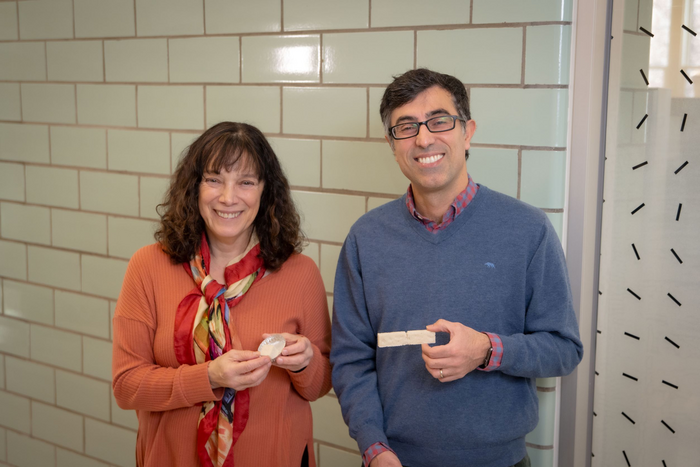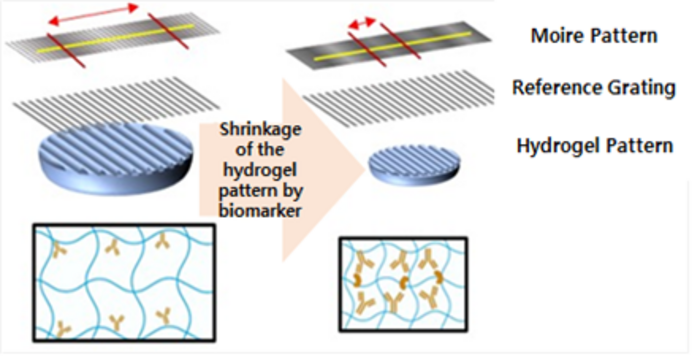Worcester, Mass – September 13, 2022 – Worcester Polytechnic Institute (WPI) researchers Nima Rahbar and Suzanne Scarlata have received $692,386 from the National Science Foundation (NSF) to improve and develop new functions for their Enzymatic Construction Material (ECM), a “living” low-cost negative-emission construction material they created to address one of the largest contributors to climate change – concrete – by providing what they refer to as “a pathway to repair or even replace [traditional] concrete in the future.” Rahbar and Scarlata have already made their research available for commercial use through a start-up called Enzymatic, Inc.; this new funding will also allow them to:

Credit: Matthew Burgos
Worcester, Mass – September 13, 2022 – Worcester Polytechnic Institute (WPI) researchers Nima Rahbar and Suzanne Scarlata have received $692,386 from the National Science Foundation (NSF) to improve and develop new functions for their Enzymatic Construction Material (ECM), a “living” low-cost negative-emission construction material they created to address one of the largest contributors to climate change – concrete – by providing what they refer to as “a pathway to repair or even replace [traditional] concrete in the future.” Rahbar and Scarlata have already made their research available for commercial use through a start-up called Enzymatic, Inc.; this new funding will also allow them to:
- explore new avenues for ECM’s use, including repairing cracks in different types of glass, such as eyeglass lenses, cell phone screens, and car windshields.
- develop a program to educate diverse populations of underprivileged girls—in Worcester and in Africa—about engineering and construction.
About ECM – the need, the science, and the process
According to Statisa, between 1995 and 2020 worldwide cement production jumped from 1.39 billion to 4.1 billion tons, making it the second most widely used substance on Earth next to water. In addition to their efforts to help mitigate the massive climate change impacts created by concrete, Rahbar and Scarlata plan to use the new funding to refine and optimize ECM and the processes to create it, and expand its use to different materials.
Biological enzymes are catalysts that drive chemical reactions. ECM is made through a process involving an enzyme known as carbonic anhydrase—found in all living cells—that has the unique ability to react with CO2 to rapidly remove the greenhouse gas from the atmosphere. This reaction creates calcium carbonate crystals, which serve as ECM’s main ingredient. A sand slurry is also added, as well as a polymer, which holds the ECM together during its early stages, much like scaffolding does during the construction of a building. Through this process, ECM can “heal itself” and fix cracks or other imperfections that may develop over time, retaining its strength through as many as six self-healing cycles.
Through extensive testing and experimentation, the research team found that ECM has “outstanding” compression strength, rivaling traditional mortar, making it strong enough to be used in the construction of buildings as compressive elements. It also does not require baking at high temperatures like a traditional brick does, and it can be made quickly, unlike the 28 days needed to cure concrete. ECM can also be produced at a low cost as the percentage of the enzymes is minute. This new NSF funding will help the team improve the processes that will allow for EMC to move more swiftly from the lab to construction sites.
A new pathway for the material could also be used to fix cracked or fractured glass. Scarlata says the inspiration came to her through something many parents can relate to—her children accidentally dropped and broke their cell phone screens—leading her to want to find a way to repair, rather than replace, the phones’ glass screens. While Scarlata and Rahbar don’t have any data yet on ECM’s ability to repair glass, they believe it is possible. “This method of repairing glass would save a lot of time, energy, and waste, says Scarlata. Rahbar adds, “it’s a dream right now, but that science evolves … through dreams.”
What it means for girls, and why it matters to the construction industry
In addition, the grant will allow Rahbar and Scarlata to develop a program based on their lab work on ECM to educate and inspire underrepresented and underprivileged girls about engineering and construction, an industry where the gender gap is stark; according to OSHA, only 9 percent of construction workers in this country are women.
The researchers plan to partner with organizations in Worcester, including the local chapter of Girls Inc. to create summer programs and after-school programs in which girls will design a six-inch model building, make a mold for it using 3D printing, and build the structure out of ECM. Rahbar and Scarlata are also collaborating with the African University of Science and Technology to host visiting graduate students at WPI and conduct additional summer programs for this group. “Construction has traditionally been a man’s field and has been overlooked by young women as a potential career, but women have a lot to contribute, in all areas, including construction,” said Scarlata.
The company making ECM a commercial reality
Working with Todd Keillor in WPI’s Office of Technology Commercialization, Scarlata and Rahbar created Enzymatic, Inc., a start-up company launched to realize commercial opportunities for ECM and an earlier product—a self-healing concrete—they developed in their initial collaboration. Scarlata and Rahbar serve as scientific advisors for the company. CEO Charles Maddox is a WPI MBA graduate with expertise in the field. He will be developing and driving the business plan for the organization. Keillor says finding Maddox and working with him were critical factors in the formation of the company. “This is often the missing piece when trying to get an academic-based startup off the ground,” he says, “and Charlie completes the puzzle. I’m confident he will have the company poised for growth.”
About Worcester Polytechnic Institute
WPI, a global leader in project-based learning, is a distinctive, top-tier technological university founded in 1865 on the principle that students learn most effectively by applying the theory learned in the classroom to the practice of solving real-world problems. Recognized by the National Academy of Engineering with the 2016 Bernard M. Gordon Prize for Innovation in Engineering and Technology Education, WPI’s pioneering project-based curriculum engages undergraduates in solving important scientific, technological, and societal problems throughout their education and at more than 50 project centers around the world. WPI offers more than 70 bachelor’s, master’s, and doctoral degree programs across 18 academic departments in science, engineering, technology, business, the social sciences, and the humanities and arts. Its faculty and students pursue groundbreaking research to meet ongoing challenges in health and biotechnology; robotics and the internet of things; advanced materials and manufacturing; cyber, data, and security systems; learning science; and more. www.wpi.edu
Journal
Cell Reports Physical Science
DOI
10.1016/j.xcrp.2022.101039
Method of Research
Experimental study
Subject of Research
Not applicable
Article Title
Curing and self-healing of enzymatic construction materials using nanoparticles
Article Publication Date
2-Sep-2022





